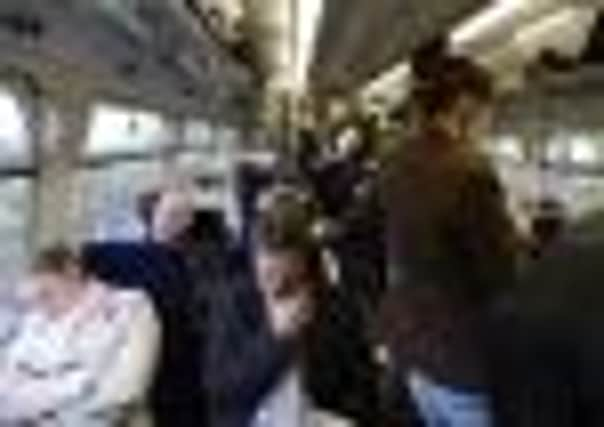Standing room only for many Yorkshire rail passengers


Morning rush-hour overcrowding is at its worst on services into London’s Paddington station, the statistics from the Office of Rail Regulation (ORR) revealed.
Outside London, Leeds has the highest number of standard-class passengers forced to stand, with 14% standing on arrival at the city centre in the morning peak and 12.1% standing on departing trains in the afternoon peak.
Advertisement
Hide AdAdvertisement
Hide AdThe ORR figures related to morning and afternoon peaks on London and south-east rail services in autumn 2010.
The statistics showed that overall crowding, as measured by the percentage of passengers in excess of capacity, was 3%.
This was a return to the level recorded in 2008 following the decrease to 2.2% in 2009.
Services into Paddington in the morning peak had a crowding figure as high as 18.5% while the First Great Western train company had the highest levels of crowding (16.6%) across the morning and evening peak.
Advertisement
Hide AdAdvertisement
Hide AdThe figures also revealed that in London and the south east, trains were more crowded in the morning peak (with a crowding figure of 4.0%) than in the afternoon (1.9%).
But in major regional cities on a typical autumn 2010 weekday, trains were generally more crowded in the afternoon peak than in the morning.
Birmingham had the highest passenger demand, with 36,100 passengers departing from the city during the afternoon peak on a typical weekday in autumn 2010. This was followed by Manchester (29,400 departures) and Leeds (23,800).
David Sidebottom, director of rail customer watchdog Passenger Focus, said: “Getting a seat is a daily struggle for some passengers as overcrowding on the railways continues to be a big problem.
Advertisement
Hide AdAdvertisement
Hide Ad“While we welcome that more people are taking the train, the issue is where they are all going to sit.
“Train companies’ franchise agreements state that services need to be planned so that passengers ought not to stand for more than 20 minutes.
“The industry needs to address this through increasing capacity by more trains and carriages, upgrading railway infrastructure such as new signal technology, track work, longer station platforms and new lines.”
Separate figures released today by the Department for Transport (DfT) showed the 10 most overcrowded train services arriving at or departing from London during the morning and afternoon peaks in autumn 2010.
Advertisement
Hide AdAdvertisement
Hide AdAll 10 were trains operated by First Great Western (FGW), with the most crowded being the 6.37am Reading to Paddington service.
This particular three-carriage train has a standard-class capacity of 304, but carried as many as 610 standard-class passengers at the most crowded point of its journey.
The second most-crowded train was FGW’s 6.45pm Paddington to Reading service. This three-car train had 304 standard-class capacity but had a 588-passenger load.
The 10 most-crowded services in autumn 2010 ranged from being 60% overcrowded to 101% in the case of the 6.37am Reading-London train.
Advertisement
Hide AdAdvertisement
Hide AdThe DfT also published figures for the 10 most-crowded services in spring 2010, which showed that the problem had worsened as 2010 went on.
The spring 2010 figures were again dominated by FGW, with seven of the 10 trains being operated by the company.
The worst spring 2010 service for overcrowding was FGW’s 5.02am Worcester Shrub Hill to Paddington, which was 67% above capacity.
Rail Minister Theresa Villiers said: “These figures clearly demonstrate the importance of our plans to tackle overcrowding on our railways.
Advertisement
Hide AdAdvertisement
Hide Ad“We are now embarked on one of the biggest programmes of rail capacity improvement for a hundred years, including more than 2,700 new rail carriages, a £900 million programme to electrify more rail lines, the vital Crossrail and Thameslink projects, the long-awaited Tube upgrades and light rail extensions in Birmingham, Newcastle and Manchester.”
She went on: “Just yesterday I was able to announce funding for extra carriages that will provide space for 8,800 more passengers on busy routes.
“These investments are possible - despite the deficit we inherited - because of the difficult decision we have made to increase rail fares from next year.
“However, we need to do more than just invest in the existing network. Many lines are almost full and major new capacity will be needed in the years to come.
Advertisement
Hide AdAdvertisement
Hide Ad“A high speed rail (HSR) network could provide just that, freeing up space for more commuter services on the existing network as well as providing faster journeys, creating jobs and fostering regeneration.
“We are considering responses to the HSR consultation and will announce a decision towards the end of the year.”